The Chisholm Gallery has been a leading international dealer of polo and sporting art for over three decades. We strive for a mix of fine art from new and established artists in a variety of media and subject matter. We also work with our clients to build art collections and integrate them into your life and home. Please feel free to look through the galleries on this website and contact us if anything sparks your interest.
The Art of Acquisition
Building a meaningful collection should start with being true to one’s tastes, writes gallery owner Jeanne Chisholm
View the Complete Article
Art has played a huge role in my life. My first gallery was the Suydam Gallery, which opened in 1976 at 112 East 85th Street, New York, in a fabulous townhouse. I lived on the top two floors with my gallery space on the ground and first floor. There was a lovely garden for receptions and outdoor art installations. We exhibited many contemporary international artists and showed art films including the Countess of Wemyss and March’s (née Amanda Feilding), short cult art film entitled Heartbeat in the Brain.
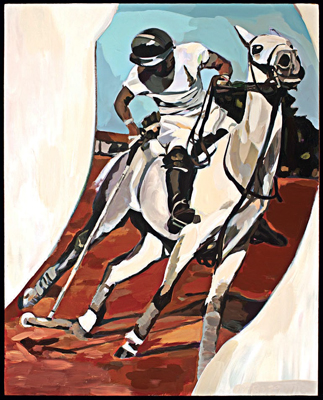 ‘Turning on a Dime’ portrait of Pete Bostwick by his granddaughter Lisa Bostwick |
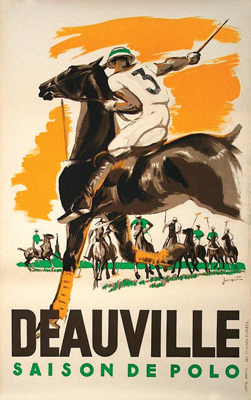 ‘Deauville Saison de Polo’ by Jean Jacquot, circa 1938 |
In 1978, my fiancé, Hugh Jeremy Chisholm (a gentleman polo player) and I were invited by William (Bill) T Ylvisaker to open a gallery at Palm Beach Polo and Country Club, which at the time was a magnet for the international jet set – the list of members read like a Who’s Who of royalty, aristocracy, and the rich and famous, as did its roster for internationally acclaimed high-goal polo players. After my husband’s tragic death from cancer in 1982 at the age of 41, I devoted myself to the continuation of his dream to further the creation of the Museum of Polo and Hall of Fame.
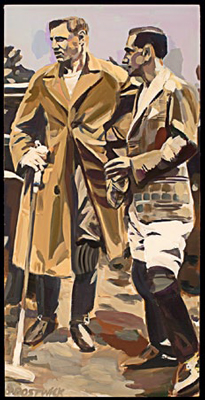 ‘Before the Match’ by Lisa Bostwick |
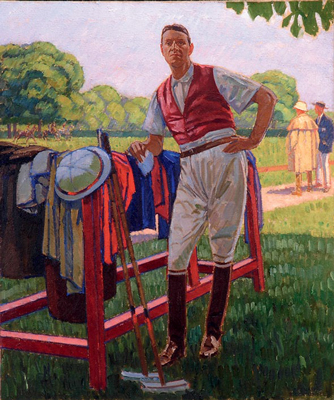 ‘Portrait en pied du Prince Léon Radziwill au polo à Bagatelle, 1910’ by Bernard Boutet de Monvel |
In the mid-Eighties the world’s top design houses turned to the Chisholm Gallery to answer their sporting art needs. These included Cartier, who asked me to curate their celebrated exhibit POLO – USA: A Retrospective History of Polo in America, which showed first in Palm Beach and later travelled to New York to Cartier’s headquarters on Fifth Avenue, and Ralph Lauren, who approached the Chisholm Gallery for artefacts and paintings to decorate its flagship store, the historic Rhinelander Mansion on New York’s Madison Avenue. Both of these projects were monumental in scope and I loved the quest to find the most rare and elusive polo paintings, bronzes, photographs, decorations, books and ephemera. I still do to this day!
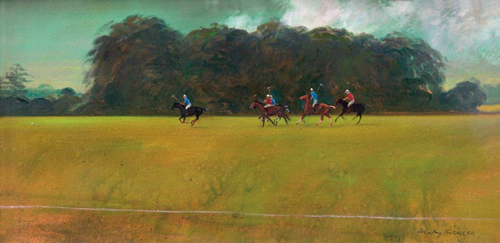 ‘Polo at Cirencester Park’, by Henry Koehler, 1973 |
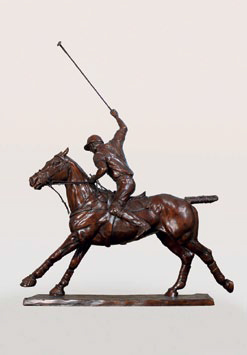 ‘Polo XI: Offside forehand’ by Gill Parker |
My work with museums has included the Aiken Thoroughbred Racing Museum and Hall of Fame, in Aiken, South Carolina (which enlisted Chisholm Gallery to curate an exhibit commemorating 100 years of polo history), the National Museum of Dance and Hall of Fame in Saratoga Springs, New York, and most significantly the National Polo Museum and Hall of Fame. I served as Coordinating Director for the latter, an idea that was fostered by H Jeremy Chisholm in
the Seventies. The Chisholm Gallery was further invited to participate in the first-ever sporting art exhibit at the prestigious Colnaghi Gallery in London.
 Four polo prints by American artist Paul Brown |
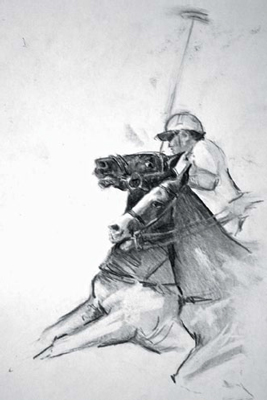 ‘The Ride Off’ by Catherine Ingleby |
The Chisholm Gallery represents over 200 wonderfully diverse and talented artists in nearly 20 countries and remains vitally involved in promoting and elevating their work in the larger international arenas of the art world. We specialise in polo and sporting art, bronzes, trophies and awards, rare books, and equestrian gifts, with many of our clients being polo patrons and art collectors.
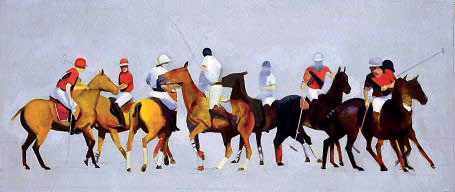
‘Harvard/Yale Polo’ by Michael Antonio Poncé, circa 2000
In order to collect art intelligently, you must first master two basic skills. The first is being able to effectively research and evaluate works of art that attract you. The second is being able to collate individual works to form meaning within their grouping; this is the art of collecting.
If you’re like most people, you know how to buy art on a piece-by-piece basis, but may not be all that accomplished at building a collection. Interesting art can be found just about anywhere, in an incredible variety of subjects, media and prices – but this variation can be confusing and intimidating. So how do you decide which direction to go in? How can you relate one purchase to the next?
Great collectors are often as well known as the art they collect. Take the Rockefeller collection, the Phillips Collection, the Chrysler collection, to name but a few; these collectors are famous because they demonstrate just as much talent in selecting and grouping their art as the artists show in creating it. Indeed, each work of art commands superior attention and price not only because of its quality, but the company that it keeps: in any mature collection, the whole becomes greater than the sum of the parts. What makes a collector truly great is their ability to select and assemble works in such a way as to expand our understanding of that art. Successful collectors spot trends in world art and request works by certain artists or speciality publishers. In many cases, when I find what my clients want, I locate similar works myself. It is often those who make the initial requests who influence my stock and the direction of my buying.
Regardless of whether professional or recreational, there are techniques for all collectors in order to maximise the quality and value of your art, as well as your personal enjoyment of it. The first step is being true to your tastes. This means acknowledging your preference of art regardless of current trends. All great collectors share this trait – their personality makes their collections stand out. When personal preference is ignored in favour of the status quo, one collection begins to look just like the next. A few people dictate, the masses follow, and collections become boring and repetitive.
Collectors who aren’t afraid to express themselves yield exactly the opposite results. Take, for example, the artist who put together a collection of paintings bought exclusively second-hand, often for little more than a few dollars each, and yet his collection toured the country and was later published as a book. Many of us are not only entertained but also educated – he teaches us that art can be found anywhere, not just in major museums and galleries; and he would never have put this collection together if he had chosen to mimic the tastes of others rather than to be true to his own.
If you’re an art collector, don’t confine yourself to the same museums and galleries. Explore the less conventional if that’s what you’re curious about. Don’t be afraid to experiment – something new may thrill you at some point. Periodic reappraisals of your tastes are always a good idea: what excites you today could easily bore you tomorrow. A quality collection is always evolving and never static.
As you gain experience, the reasons why you buy should become increasingly more conscious and purposeful. Fine art is an investment which has been making huge financial news for decades, and will continue to do so. I have hundreds of letters from grateful collectors who have seen their paintings and bronzes grow in value since we first opened the doors of the Chisholm Gallery at Palm Beach Polo and Country Club in 1978 with my late and beloved husband, Hugh Jeremy Chisholm, one of the four founders of the National Museum of Polo and Hall of Fame. Experienced collectors show a sense of direction.
And here’s where we get into the essence of collecting, of what distinguishes a superior collection from an inferior one. In a superior collection, every piece belongs; nothing is random or arbitrary. A less experienced collector, on the other hand, may know plenty about each individual work of art, but lack an overall understanding of how pieces work together, or even if they work together.
Another aspect of good collecting is documenting your art. You can see best how documentation affects older art. Suppose, for instance, that two 19th-century equestrian paintings by Rosa Bonheur come up for auction at the same time, and are virtually identical. The first is catalogued rather dully as ‘Ploughing Scene’. The second is catalogued as “‘The Horse Fair’, exhibited at the Salon of 1853 and now in the Metropolitan Museum of Art in New York City”. Assuming you find both paintings equally appealing, which would you rather own? Which will sell for more money? The latter, of course. It’s like choosing between a rescue dog and a pedigree.
Whenever art dealers and auction houses take on works with poor documentation, they do their best to come up with exciting titles: they know that good titles sell faster.Having good documentation tends to increase the value of art. Imagine if you had an original receipt from the sale of a Van Gogh painting that changed hands in the early part of this century. Or perhaps your grandfather bought a Picasso and received an inscribed photo of Picasso handing him the painting. I can assure you that either of these items would be worth well into the thousands of dollars today.
The worst possible outcome for a collection occurs when the owner passes away and leaves no information about the art. Countless collections have been resold for pennies on the dollar, or even thrown in the trash. I remember receiving a call one day from a haulier who said he had some art in a storage space. He mentioned the artist who I immediately recognized as a well-known Palm Beach area painter. It turned out that the haulier had been asked to cart away seven major paintings by the artist which, at that time, were worth between thirty and fifty thousand dollars. The owners had simply thrown them out. In fact, he had actually been paid to take them away!
The lesson in all this is that collectors, no matter how large or small their collections, should provide a complete list of instructions for those who will inherit their art. It is important to include names, addresses, phone numbers, procedures, values, and all other particulars for selling or donating as well as for dispersal within the family. If you expect to have any influence over the long-term future of your collection, lay the groundwork now. Educate your family about what you own. Ultimately you need to instil a love and respect for what you’ve accomplished, and make sure that they understand how important it is to you.
Chisholm Gallery now offers handcrafted sterling silver and lead-free pewter polo and racing trophies, loving cups and derby bowls, wine coolers, fox and hound giftware and stirrup cups. All available with engraving; chisholmgallery.com
Derrydale Press, New York, 1930 ~ Hand-colored aquatint engravings
Only 175 signed proofs were produced of each print, which makes a bona fide set of four rare and valuable.
A set of four hand-coloured intaglio aquatint ‘American Polo Scene’ prints by the American artist, Paul Brown, titled ‘On The Boards’, ‘The Save’, ‘The Goal’ and ‘Down The Field’; each signed.
Dimensions of each: 17 x 24 inches (43 x 61 cm). Plate size: 12 ½ x 20 inches. Printed on imported handmade paper. Titles engraved in the same style as other sets of American Sporting scenes published by The Derrydale Press, New York, 1930.
Signed in pencil by the Artist. One of 175 sets. Matted with extra-large mats. Framed and glazed. Ordeman pp. 33-36, 103.
Ordeman says these “are among the most sought after and expensive Derrydale prints”.
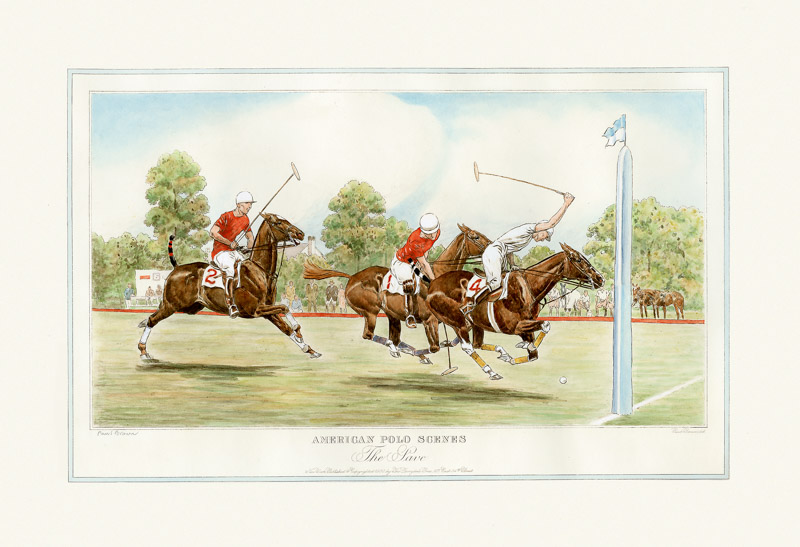
‘The Save’

‘The Goal’
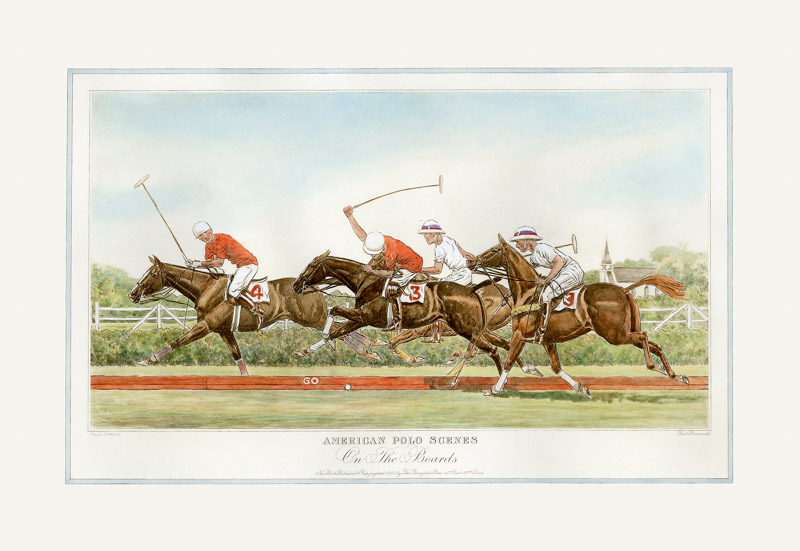
‘On The Boards’
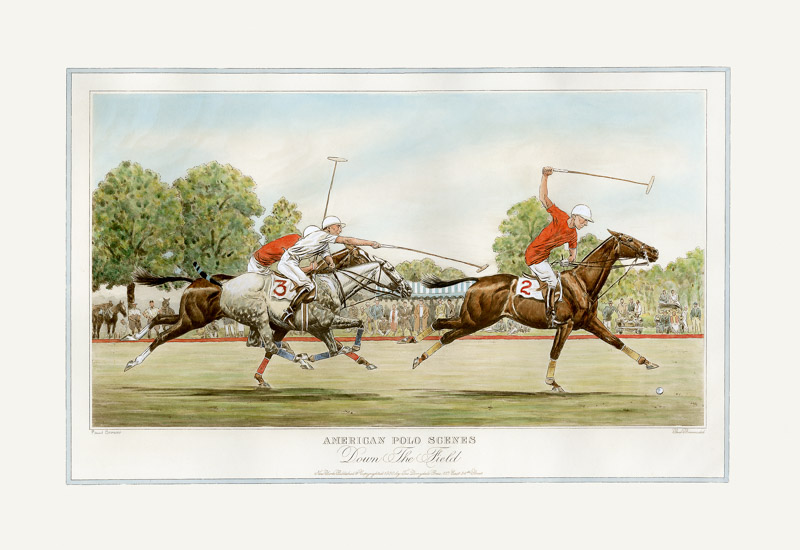
‘Down The Field’
Paul Desmond Brown
American, (1893-1960)
Brown is primarily known for his wonderful paintings, drawings and sketches of horses and equestrian sports. He is also well-known for his elegant and prolific illustrations for Brooks Brothers catalogs over three decades, including more than one thousand drawings, making him a major influence on the image of urban males in twentieth-century America.
Paul Brown’s art is alive, original and strong without presumption. Color is only an occasional adjunct playing a very secondary role to the use of the hard-edged line. His style has a calculated simplicity and casual appearance, but is very carefully contrived and executed with much authority.
He used his wonderful powers of observation, drew heavily upon his copious notes and studies and greatly accepted the benefits of the camera only to cement his ideas. The rest was practice and care. His photographic memory proved to be an invaluable asset, enabling him to render images of specific moments sometimes years after they had taken place. Brown preferred to draw with a pencil and, although not fond of painting, he successfully employed a technique of using tinted paper with white highlights.
During the heyday of polo in the 1930′s, Paul Brown immortalized the sport for many in his illustrations for Peter Vischer’s POLO magazine, of which Brown was a member of the editorial board. Today those historical moments are often taken for granted, as is much of the past, but we still have Paul Brown’s unique legacy to breathe life into those special times.
Illustrating and writing books became Brown’s main occupation with the major publishers of the day including The Derrydale Press, Charles Scribner’s Sons, Dodd, Mead & Company. These books are avidly collected today and often fetch as much as an original work of art.
View Paul Brown’s Artist Page
SPECIAL ESTATE OFFERING: THE SET OF FOUR
Paul Desmond Brown (American, 1893-1958)
Paul Brown, 1937, Derrydale Press, a set of 4 FOXHUNTING Hand-Coloured Aquatints on offer from Chisholm Gallery, LLC beautifully matted and framed at 24 x 32 inches
KENNEL BOUND (1 of 4)
The Derrydale Press, New York, 1937
Plate size: 21 3/4 “ x 7 7/8 “
Paper size: 31 “ x 22 7/8” with generous margins.
Paper: Hand made w/ deckel edges
Edition: 101/250
Signed & Numbered in pencil
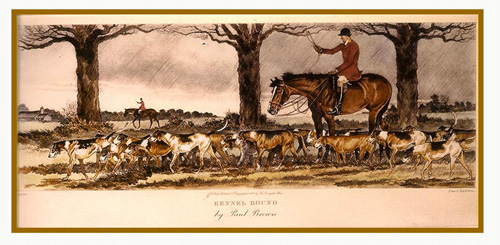
PRESSING HIM (2 of 4)
The Derrydale Press, New York, 1937
Plate size: 21 3/4 “ x 7 7/8 “
Paper size: 31 “ x 22 7/8” with generous margins.
Paper: Hand made w/ deckel edges
Edition:74/250
Signed & Numbered in pencil
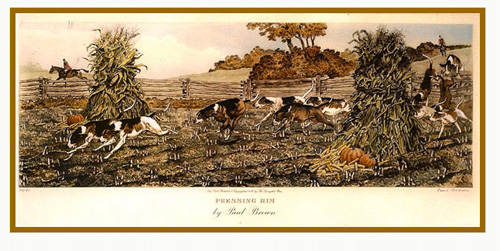
MUSIC AHEAD (3 of 4)
The Derrydale Press, New York, 1937
Plate size: 21 3/4 “ x 7 7/8 “
Paper size: 31 “ x 22 7/8” with generous margins.
Paper: Hand made w/ deckel edges
Edition:74/250
Signed & Numbered in pencil

HOICK! HOICK! HOICK! (4 of 4)
The Derrydale Press, New York, 1937
Plate size: 21 3/4 “ x 7 7/8 “
Paper size: 31 “ x 22 7/8” with generous margins.
Paper: Hand made w/ deckel edges
Edition: 101/250
Signed & Numbered in pencil
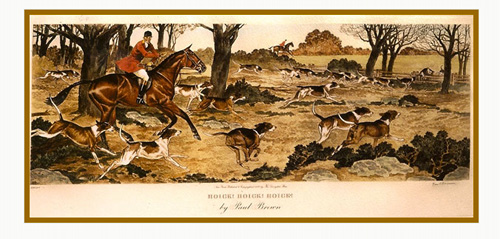
Limited to 250 numbered and signed prints. Derrydale Press. Even though the set was advertised as being produced in an edition of 250, most collectors and dealers in sporting art believe that there were many fewer actually produced.
Titles engraved in the same style as other sets of American Sporting scenes published by The Derrydale Press.
A bona fide set of four are rare and valuable.
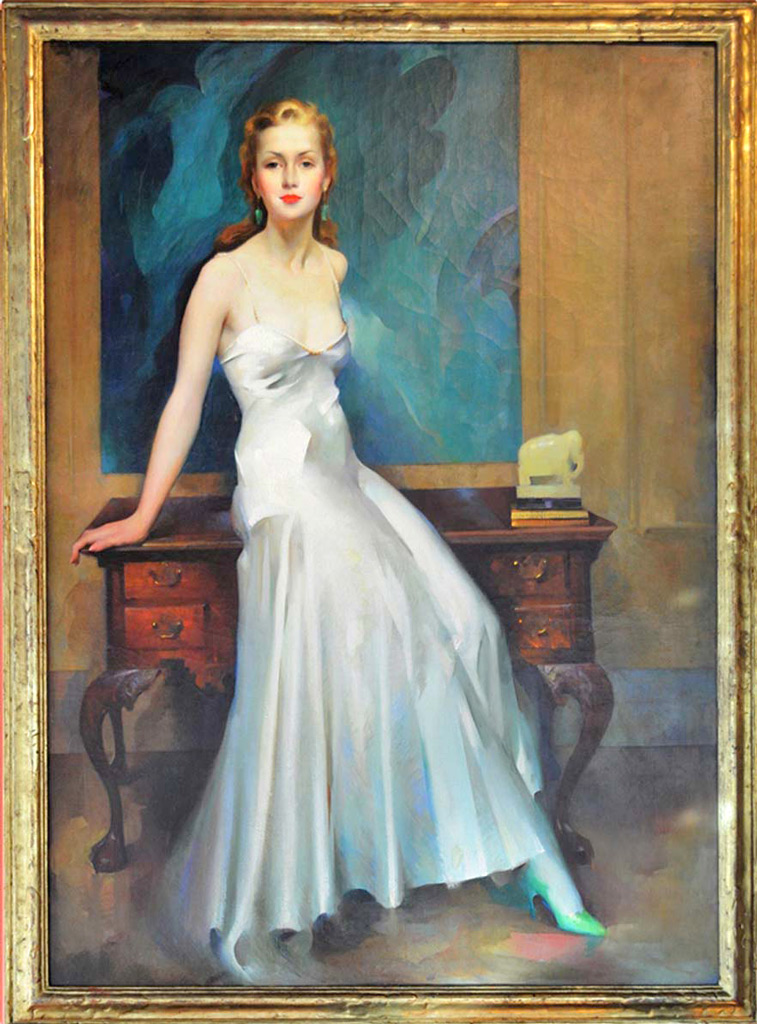


















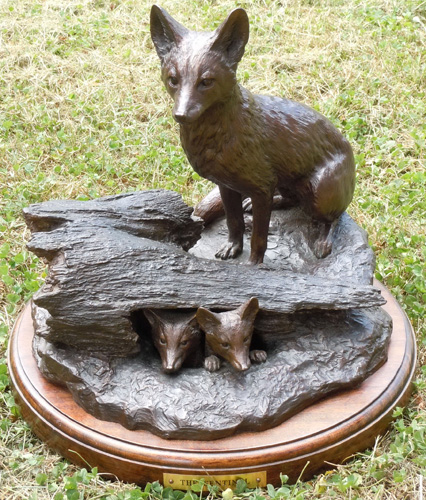
Social Media
Friend Us on Facebook Link With Us on LinkedIn Follow Us on Twitter Join me on Pinterest Join me on Google Plus